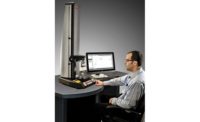As auto makers strive to meet increasingly stringent requirements for weight reduction with a range of high strength lightweight materials, many manufacturers are moving to a mixed materials environment.
A mixed materials environment requires understanding the limitations and advantages of specific materials ranging from metal alloys to composites and the methods available to join them.
Tensile testing has long been employed to characterize the strength and performance of materials. As advanced materials and novel alloys take their place in automotive manufacturing, tensile testing continues to play a substantial role in qualifying performance and ensuring quality production.
Mixed material strategies are emerging to support manufacturer compliance with new CAFE standards for fuel efficiency. The result is increased demand for materials that perform reliably at a fraction of the weight. Tensile tests support such analyses, especially when it comes to assessing weld integrity and evaluating other joining methods.
The most advanced testing systems must support the high throughput test environment mandated by both materials selection routines and quality management processes for lightweighting initiatives. Rapid test and positioning speeds, coupled with fast return, reduce cycle times for testing. Intelligent features such as recognition of the complete test environment, sophisticated strain-rate control, and online compensation for changes in specimen properties enable lab managers to spend more time focusing on results analysis than test setup.
The tensile test can provide information that will be used in design parameters and to demonstrate that a material or component complies with the requirements of the appropriate specification; it may therefore be either a quantitative or a qualitative test.
In recent years, aluminum has become a mainstream material for the production of body and chassis components in passenger vehicles. The use of aluminum introduces new challenges in the area of joining. As aluminum is not an ideal material for welding, automakers prefer redundancy in fastening solutions. The introduction of aluminum requires new joining techniques including self-piercing rivets and adhesives. A number of technology improvements in the area of adhesives have further supported the migration to mixed materials. When Jaguar Land Rover rolled out production of its Range Rover L405 model, the company moved to an all-aluminum monocoque body structure that required substantial amounts of adhesive to achieve proper joining. Alcoa has introduced a pretreatment bonding technology, known as Alcoa 951, which enables more durable bonding of aluminum components in vehicles, can reduce spot weld points, and also reduces manufacturing costs.
Tensile testing can also be used to test the strength of composite materials and bonds. Composites are following the classic adoption curve within the automotive industry. Entry occurred first in the racing and performance classes, with mainstream market applications emerging more recently.
Carbon fiber-reinforced plastics (CFRPs) deliver the benefits of high strength with ultra-low weight, but require costly technology investments. Low volume production makes it difficult to exercise economies of scale using CFRPs in select applications. Supply chain optimization, refinement of manufacturing techniques, and installation of quality assurance infrastructure are key to volume applications of CFRPs in the automotive industry. BMW has invested substantially in each of these areas. Last year, the automaker announced its i3 and i8 all-electric vehicles, both of which have bodies consisting solely of CFRPs. Vehicles are constructed of two major units—a CFRP-based passenger portion and an aluminum-based drive module.
Joining steel, aluminum, and alloy-based components poses one set of challenges, while joining metals to composites creates new ones. Structural adhesives must be thoroughly characterized to assess their capacity to cohesively join dissimilar surfaces, manage the varying expansion rates of the materials to which they are bonded, and enable the properties profile required by the application. Adhesives create specific quality control challenges, not the least of which is environmental. Temperature control is necessary to ensure correct bonding and curing of adhesives on a tight time schedule. Maintaining uniform adhesive thickness is also critical. Adhesives can be problematic with regard to lightweighting initiatives, because bonding compounds typically weigh more than rivets or spot welds.
Adhesive quality control begins with the supply chain. Adhesive properties need to be standardized to ensure consistency and integrity in the bonding process. Testing of joints between materials usually requires destructive testing and knowledge of mechanical engineering. As new adhesives are developed, quality control of advanced materials will require greater knowledge of chemical engineering.
Tensile testing employs test specimens that bear a specialized shape designed to induce deformation and failure as close to the center of the specimen as possible. Tensile tests may also be used to evaluate the performance of components. In component testing, the goal is often to determine whether basic properties, such as ultimate tensile strength, fall within a range of acceptable values for manufacturing.
Quality assurance initiatives in the automotive industry frequently employ tensile tests as a means of determining weld integrity. Daimler uses a tensile test to assess the strength of welded components.
When forming properties of metals are of interest, tensile tests represent a useful technique, as these tests may be utilized to determine n- and r-values. The n-value describes the work hardening during plastic deformation up to uniform elongation, while the r-value describes the vertical anisotropy. The n-value is determined from the tensile stress data and strain values while measurement of the transverse strain on the tensile specimen determines the r-value. Both contact and noncontact extensometers may be employed to measure axial and transverse strain, respectively.
Fiber-reinforced composites provide high strength and stiffness in combination with low weight. Composites are anisotropic, exhibiting different properties in different directions. They also consist of thin fibers which are either directionally or randomly oriented. Due to their anisotropic nature and wide range of fiber orientations, thorough analysis of composite properties requires that these materials be subjected to a spectrum of tests.
While the typical tensile test does not represent sufficient input for robust characterization of fiber-reinforced composites, the results from a tensile test do support material specifications, qualification and certification of carbon fiber used for the manufacture of such composite materials.
Tensile tests on unidirectionally reinforced materials such as pultruded rods or resin-impregnated fiber tows require a great deal of experience in the selection of a suitable clamping fixture. In many cases the specimen must be protected by tabs to avoid premature fiber breakage in the clamped area. There are, however, solutions which avoid the use of these tabs and the associated extra specimen preparation, delivering efficiency gains in test setup.
Once selection of the proper clamping fixture is complete, the next step is to identify a means of measuring strain. Signal conditioners and electronics for measurements with strain gages, clip-on extensometers and user-friendly damage-resistant mechanical and optical extensometers represent available options for strain measurement.
Measurements on metals and composite materials alike benefit from the use of extensometry solutions that measure up to the point of specimen failure. Extensometry solutions must offer a high degree of robustness in operation. Leading extensometry solutions feature sensor arms that remain on the specimen until after break, providing an optimum means of measuring strain. The sensor arms are applied automatically at the start of the test and move to a safe park position once the test is complete.
Advanced control software is also available from suppliers of leading edge tensile testing solutions. Software may support conformance to a wide range of international standards for tensile testing. From ASTM E8 and ISO 6892-1 for metals to a variety of standards for plastics, composites, textiles and paper, software can provide test programs to simplify the process of testing in accordance with standards.
Typical standards used for tensile testing:
ASTM E8, Tension Tests of Metallic Materials
ASTM E21, Standard Test Methods for Elevated Temperature Tension Tests of Metallic Materials
NASM1312-18, Standard Practice, National Aerospace Standard, Fastener Test Methods; Method 18, Elevated Temperature Tensile Strength
NASM1312-8, Standard Practice, National Aerospace Standard, Fastener Test Methods, Method 8, Tensile Strength
ASTM A 370, Standard Test Methods and Definitions for Mechanical Testing of Steel Products, Sections 5-13 Tension
ASTM D 638, Standard Test Method for Tensile Properties of Plastics
ASTM F 606 / F 606 M, Standard Test Methods for Determining the Mechanical Properties of Externally and Internally Threaded Fasteners, Washers, Direct Tension Indicators, and Rivets
ASTM D 3039/D 3039M, Standard Test Method for Tensile Properties of Polymer Matrix Composite Materials
For more information, call (770) 420-6555, email [email protected] or visit www.zwick.com.




